Holiday Houseplants
Plants make perfect decorations and gifts during the holidays, especially Thanksgiving and Christmas. To keep the beauty of these plants through the holidays and beyond, you must understand their needs. Here are some plants typically available during the holidays.
Amaryllis

Amaryllis is a popular indoor flowering plant in the winter and spring. It has large, showy blooms in colors ranging from white to shades of pink, salmon, red, and orange. It is the easiest bulb to bring into bloom, as it does not require precooling to flower like daffodils and tulips. If you cannot pot your new bulb immediately, keep it in a cool, dry location with good air circulation. Do not expose it to freezing, damp conditions. When ready to pot, use a container no larger than 1½ times the diameter of the bulb as it likes to be pot bound. Use a good potting mix, and sink the bulb up to the neck. Place in a warm, bright light situation, and water sparingly until the stem appears. As the bud and leaves appear, gradually water more. Do not overwater because this will cause the bulb to rot. It is not necessary to fertilize the plant during flowering.
Bulbs will flower 6 to 8 weeks after potting, depending on the growing conditions and variety. When in flower, move the plant where you will receive the most enjoyment, preferably in a cool area, which will prolong the floral display. After flowering, cut the old flowering stalk off 2 inches from the bulb. Put the plant back into a warm, bright-sunlight area of your home, water, and begin fertilizing with a complete houseplant fertilizer, following the directions on the label. This will ensure that the leaves continue to grow and produce the sugars that will eventually be stored in the bulb to produce next season’s blooms.
After danger of frost has passed, move the plant outdoors to a full sun area and continue to water and fertilize as needed. In the fall, before frost, gradually decrease watering, as this will signal the plant that it is time to go dormant. As the soil dries, the foliage will begin to yellow. Move the plant (pot and all) into a cellar or other dark, dry place. Amaryllis pots can be turned on their sides and stored in the garage or under a greenhouse bench during the dormant period as well. Amaryllis bulbs should remain dormant for about 8 weeks, after which time you can bring them out and start the process over again.
Azalea
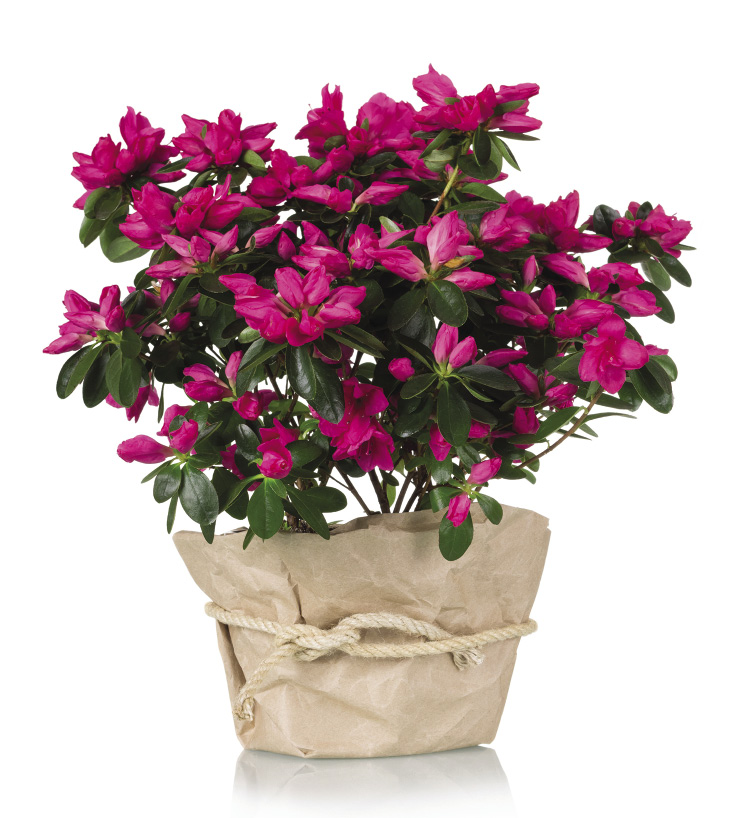
A colorful and eye-catching plant, the azalea should be kept in a location with bright light but not direct sun while in flower. Night temperatures between 55 and 60 degrees will prolong flowering. Keep the soil uniformly moist; never allow it to dry out completely.
Remove dead flowers as they begin to fade. When it’s finished flowering, you can replant your azalea in a larger container, if needed, and move it outdoors after danger of frost has passed. The azalea could be planted during the growing season into a landscape bed in a shady location. During the growing season, use a fertilizer recommended for acid-loving plants, following the directions on the label.
Whether it survives the winter in your location depends on what type of florist azalea it is. Some cultivated azalea varieties produce a robust-looking plant under greenhouse conditions and keep their good looks indoors for a few weeks, but they do not perform as well in the landscape. Be sure to ask your florist what type of azaleas they carry. If they are unsure of the winter hardiness, you may want to chance it and plant it in the garden to see if it will overwinter. If it doesn’t make it, you can always buy another holiday azalea houseplant next winter.
Because florist-type azaleas need precise growing conditions in the greenhouse for blooming in the winter months, this plant is difficult for the homeowner to achieve a repeat bloom in the home environment. Therefore, it is not recommended for this purpose.
Chrysanthemums
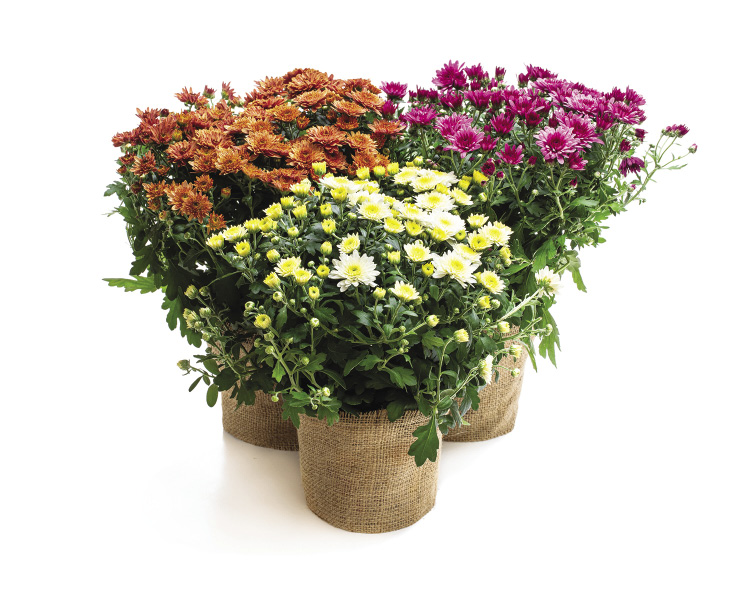
If you are looking for long-lasting color, potted chrysanthemums are a great choice. In the 20th century, they were the mainstay of all potted flowering plants but have been superseded by orchids. Now, varieties new, as well as tried and true, can be spotted in supermarket floral departments, florists, and other retail plant outlets. Chrysanthemums, also known as mums, are triggered into flowering by the shortening of day length. Therefore, the natural time to find them in bloom in the garden is in the fall, when nights are getting longer, until frost kills the above-ground portion of the plant.
Due to commercial growers’ ability to force these plants into flower, mums are available year-round. Coupled with an amazing number of cultivated varieties in numerous flower forms and colors, mums are the perfect plant for all holidays and occasions.
The National Chrysanthemum Society groups these plants by the forms of their blooms. There are 13 classes, which include flowers resembling anemones, flowers with spoon-shaped petals and quills, and flowers with petals that curve in or reflex outward. Mums will keep their colorful blooms longer if they are kept in bright light and cool temperatures.
Cyclamen
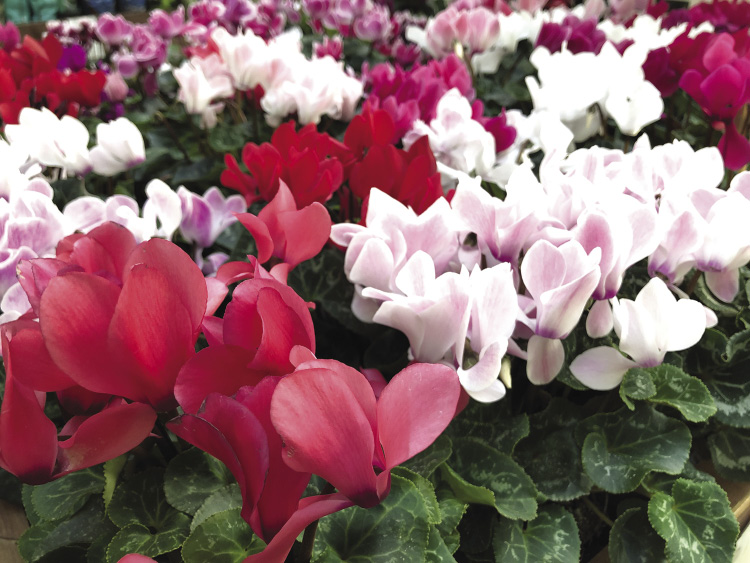
Cyclamen plants are available in the winter and spring and are more popular than poinsettias as Christmas plants in Europe. Cyclamen flowers come in white, pink, magenta, red, lavender, and deep purple. During blooming, keep the plant cool (55 to 60 degrees) and in a room with bright, indirect light. Keep the soil moist while the plant is in bloom. Do not let it dry out. When watering a cyclamen, use lukewarm water and avoid dampening the crown. Water all around the inside of the pot instead of directly over it.
Remove faded blooms at their starting point. When the flowers have faded, pull them out of the corm and begin fertilizing with a diluted solution until new leaves appear. When leaves begin to fade, stop fertilizing, and gradually reduce the water, allowing the corm to go dormant. When the soil has become completely dry and all leaves have died down, allow the plant to rest for 6 to 12 weeks in a cool, dark place. Ideally, you should allow the plant to stay dormant during the warmest weather; then it will flower in winter and spring.
Remove the corm from the pot and replant in fresh potting soil, with one-third to one-half of the corm’s top portion sticking out above the soil’s surface. When a new leaf forms, begin watering again, and fertilize once a month until flower buds form.
Dwarf Alberta Spruce
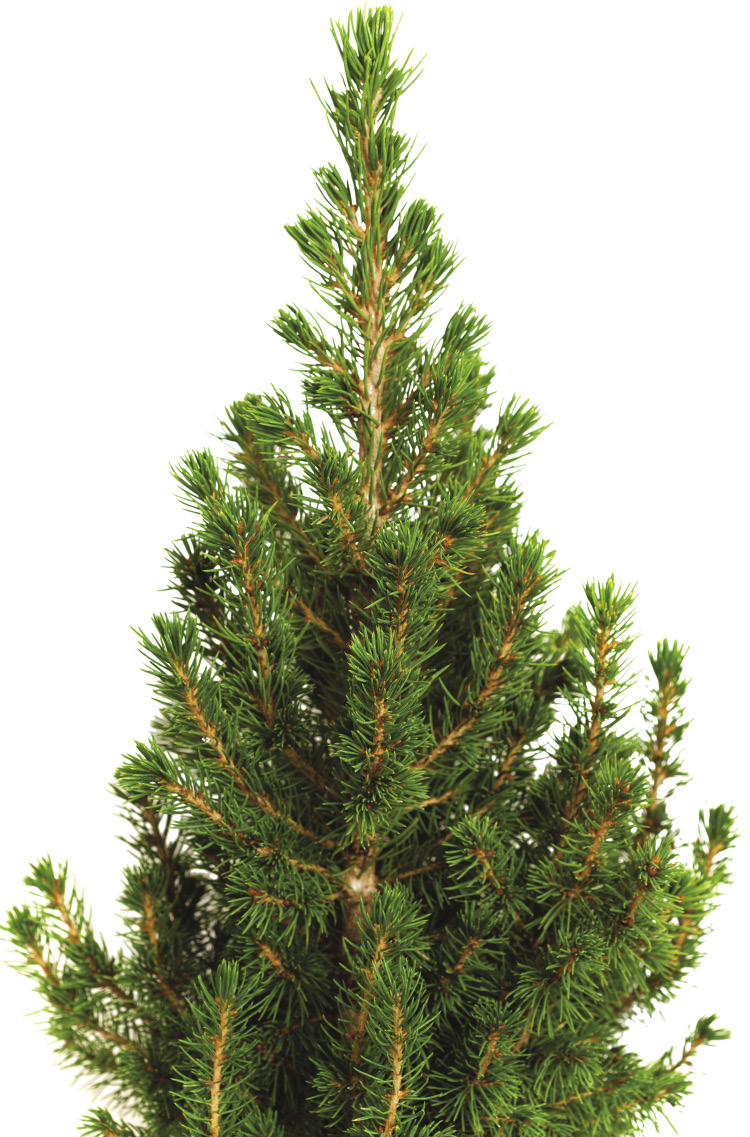
This spruce tree is often found in small pot sizes (6 to 8 inches) for use as a tabletop Christmas tree. It grows in a cone shape and is characterized by a dense, fine, blue-green needles. Dwarf Alberta Spruce (Picea glauca ‘Conica’) plants were discovered in Alberta, Canada. As such, they are acclimated to cool weather. They can grow outdoors in northern states to north Mississippi (zone 7).
Once you have selected your spruce tree, give it a thorough watering before display. Keep the soil evenly moist but not wet or standing in water.
Hyacinth
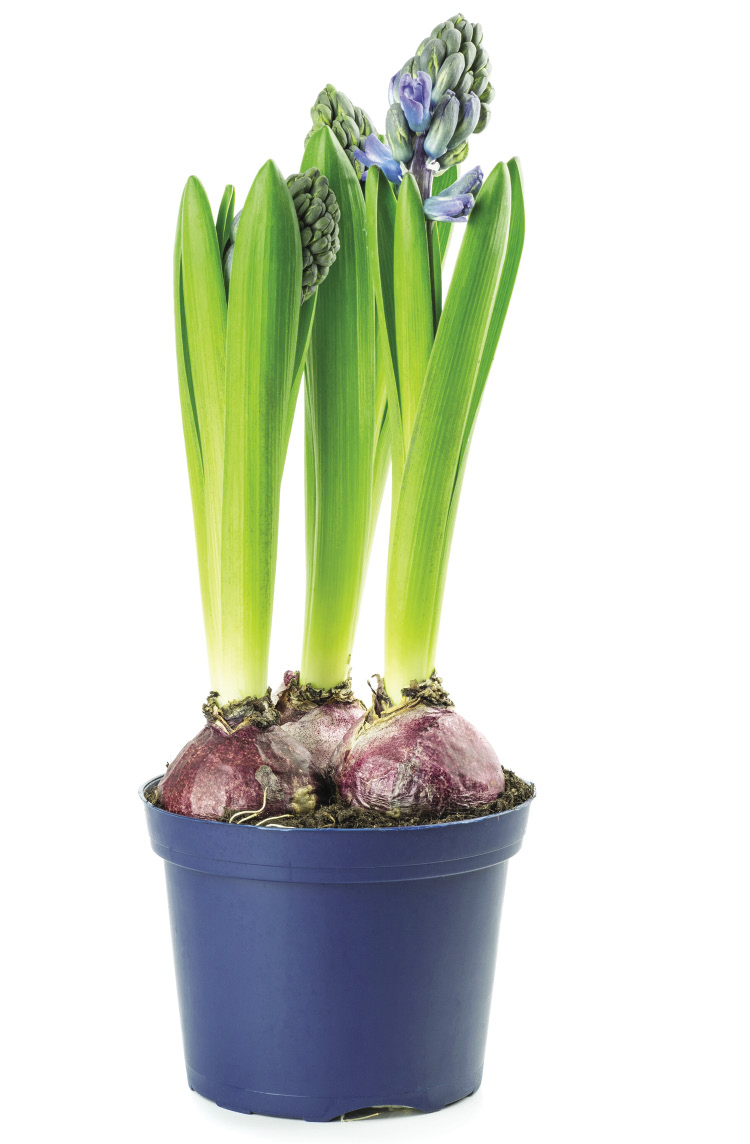
A decidedly fragrant flower, the hyacinth is appreciated by anyone who loves a breath of spring. Hyacinths are bulb plants, and their care is similar to that of tulips. You will enjoy a longer display of color if the plant is kept cool. Hyacinths are large, heavy-headed flowers bearing dozens of florets per bloom spike. Sometimes the weight of the flower head is so heavy, they need staking to keep upright. The color range of hyacinths includes white, pink, pale yellow, blue, and violet.
Hyacinth plants in bloom are frequently found in florist shops, garden centers and departments, and other floriculture outlets from Valentine’s Day through Mother’s Day. These plants have been professionally “forced” into bloom and are ready for display and gift giving. For a long-lasting display, choose plants that are just beginning to show color rather than those in full bloom.
In commercial production, hyacinth bulbs are planted in pots and then refrigerated. This cold treatment, called stratification, simulates winter and stimulates bulbs to flower. You can accomplish this at home by planting bulbs in pots and then keeping them in your refrigerator for 12 to 16 weeks. One bulb will fit in a 4-inch pot, while three are best in a 6-inch pot. After the cooling period, move the pot to a sunny window. In about 3 to 4 weeks, flowering will occur.
Keep the soil evenly moist but not wet. Hyacinth and tulip bulbs are susceptible to rotting in damp soil. If you desire a pot of blooming hyacinths throughout the winter, make up multiple pots and remove them, one pot at a time, from refrigeration every week.
Bulbs that are forced into bloom lose much energy and do not regain it the way they would if growing in their native habitats; it is best to discard them. Add the soil and contents to your garden compost pile.
Italian Stone Pine
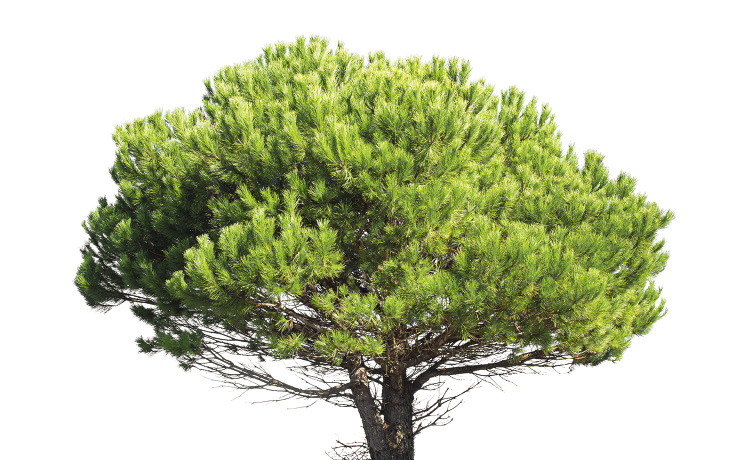
Italian stone pines (Pinus pinea), also known as umbrella pines, are native to the Mediterranean region. Young plants are pruned into a cone shape when grown in commercial nurseries. The small size (12 to 24 inches tall) make it perfect as a tabletop Christmas tree, resembling Dwarf Alberta Spruce. Mature plants produce cones that bear pine nuts used in cooking. Although your plant may not reach a stage to produce pine nuts, these plants offer an appealing way of using a live plant for holiday decorating.
Juvenile foliage tends to be bluish-green, and the plant will maintain its aesthetics if kept in bright light, in an eastern- or western-facing window. It also can do well in a southern exposure. Outdoors, they are hardy in zones 7 to 11. Keep the soil of these plants evenly moist but not wet. It will not tolerate dry soil and will show signs of die-out, especially on lower branches.
Jerusalem Cherry
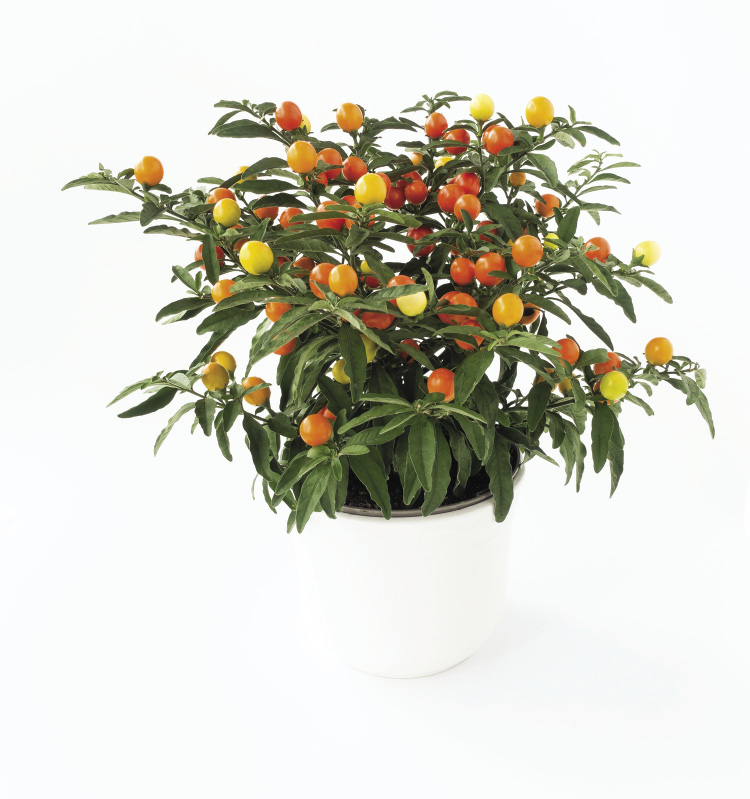
Another common holiday plant is the Jerusalem cherry, also known as the Christmas cherry or winter cherry. This bushy evergreen shrub produces white flowers in the summer that give rise to small, round, reddish-orange fruit in the winter, usually around Christmas.
As a houseplant, Jerusalem cherry requires bright light or full sun to thrive. Lack of humidity causes the plant to lose its leaves, blooms, or fruit. Keep the plant in a room with temperatures below 70 degrees. Higher temperatures may cause leaf, flower, or fruit drop. Fertilize the plant with a basic houseplant fertilizer while it is actively growing. Stop fertilizer treatment after the plant has finished blooming.
After the fruits have dropped, cut the plant back drastically and place it outside. Do not put the plant outside if temperatures are below 41 degrees. You may plant the Jerusalem cherry outside in a part-sun location. If you wish to bring it back in for the holidays, do so before the first frost. If the plant is still in flower when you bring it inside, be sure to tap or shake the plant to ensure pollination and later fruit formation. Keep the soil moist while the plant is actively growing, but do not overwater it.
Note: All parts of the Jerusalem cherry can cause severe discomfort if ingested. Keep out of the reach of children.
Kalanchoe
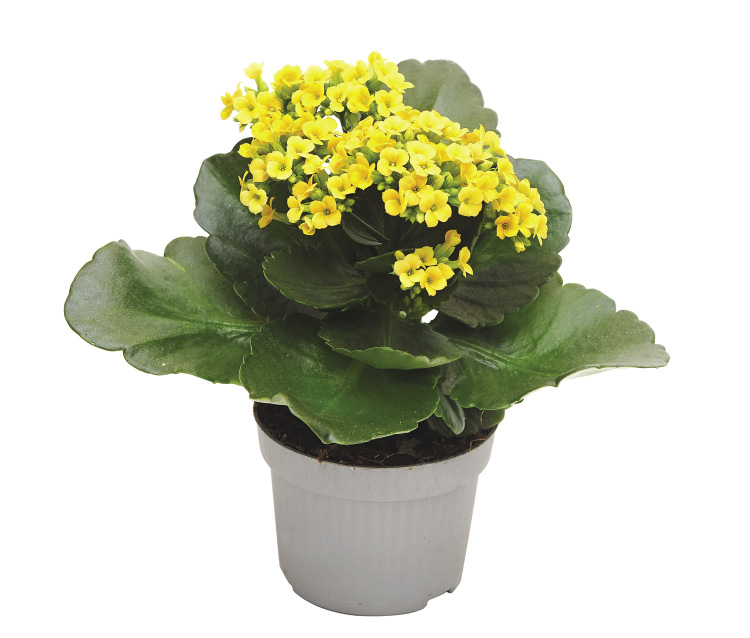
Kalanchoe plants are native to Africa and Madagascar. Flower colors include red, yellow, orange, pink, and white. Kalanchoe flowers have been bred to last a long time. While the kalanchoe is in flower, water it thoroughly, letting the soil dry between waterings. Do not keep the soil dry for too long, or the flowers will drop prematurely. Usually the soil takes 1 to 2 weeks to dry out, depending on the size of the pot and the temperature. Kalanchoes do not like wet feet, so do not overwater them. Give new plants enough fertilizer to promote growth through their first flowering. If you have an older plant, fertilize it every 3 weeks while it is in flower. Kalanchoes tolerate most light levels, but they prefer medium light. The best room temperature is 50 to 70 degrees during the day and 40 to 65 degrees at night.
After the plant has flowered, cut the flower stems back to the second or third leaf below the old flowers. You may use a standard houseplant fertilizer every 2 to 4 weeks after new growth appears. Getting a kalanchoe to reflower can be tricky. To flower, the plant needs 14 hours per day of uninterrupted darkness for 8 weeks. A small amount of light (room lights, street lamps) during this 14 hours can keep it from flowering. Do not place a kalanchoe in a dark room that does not receive any light. The more light the plant receives during the short day, the faster it will flower. An easy way to provide uninterrupted darkness is to cover your plant with a box lined with a black plastic bag every day at 5 p.m. and uncover it the next day at 8 a.m.
Lemon Cypress

Florist shops and nursery departments offer miniature evergreen trees during the holidays, some of which have been manipulated into a curved shape known as a Grinch Christmas tree. This plant is the Lemon Cypress tree (Hesperocyparis macrocarpa ‘Goldcrest’), also known as Goldcrest, Golden Crest, or Monterrey cypress. Its juvenile, yellow-green leaves are reminiscent of Dr. Seuss’s cartoon character and provide a bright pop of chartreuse to the interior. These plants are pruned so that they have a pyramidal shape. As foliage matures, it darkens in color.
Potted cypresses need sunlight and are used to bright, sunny locations outdoors. Their soil should be kept moist but not wet and should not be allowed to thoroughly dry. A good test is to insert your finger into the pot down to the first knuckle and then remove it. If soil particles adhere to your fingertip, the plant does not need water at that time. Lemon cypress can go outdoors and live as a containerized plant or be planted in the ground in USDA zones 7 to 10.
Norfolk Island Pine

Norfolk Island pines are very common during the holiday season. They are typically sold as living Christmas trees. Although many people think the Norfolk Island pine is a cold-weather plant, it is actually a tropical plant native to the southern hemisphere in Australia and the Norfolk Islands. This plant, though often used as a compact houseplant, can grow up to 200 feet in its native habitat.
Norfolk Island pines prefer high to medium light (an east- or west-facing window) and cool day temperatures (50 to 70 degrees) and night temperatures (45 to 65 degrees). Temperatures below 45 degrees can damage the growing tips of the branches.
Provide high humidity and good ventilation for the plant. Age and lack of humidity cause needles on the trunk to fall off. Water the plant on a regular basis. Dry and brown lower branches indicate the plant is dehydrated. Norfolk Island pines do not tolerate wet soil, however. Sporadic yellow needle clusters indicate the plant has been overwatered. Fertilize every 2 to 3 weeks during its active growing season (March through September).
Ornamental Peppers

Ornamental pepper plants are often found in stores during the fall season. These plants should be kept inside when temperatures are expected to drop below 40 degrees. They produce colorful fruits that come in a wide range of shapes, sizes, and colors, including brown, violet, and nearly black. A single plant can have three different colors of peppers on it. These plants make great houseplants as well as ornamental landscape plants.
Whether inside or outside, ornamental peppers need full sun or bright light. Water them regularly, letting the soil dry between waterings. Plants remain more compact if the soil is kept on the dry side. Ornamental peppers do not like wet soil. Actively growing plants need light fertilization. While peppers are inside your home, keep them in a room that stays between 50 and 70 degrees. You can eat these peppers if they have not been treated with pesticides. They may be extremely hot and bitter.
Paperwhite Narcissus
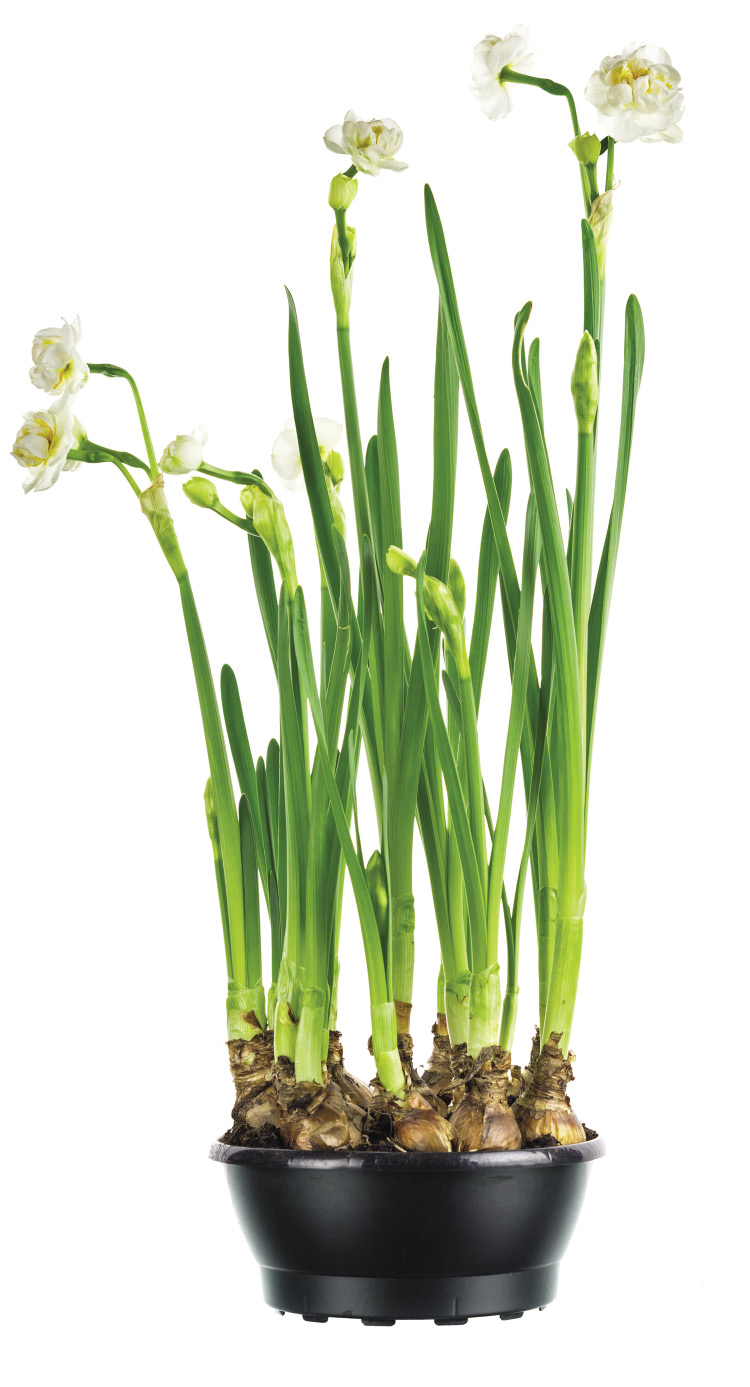
People enjoy experiencing the growth and fragrance of paperwhite narcissus in the home. The plant’s white flowers are delicate and a pleasant reminder of springtime. Dormant bulbs can be purchased from garden centers and online sources and are available in the fall. They can be planted in potting soil or gravel. If using gravel, fill a watertight container with washed pebbles and then place the bulbs, pointed side up, on the surface. Add additional gravel so that about ½ to 1 inch of the bulb is exposed. Add water to the container so that it touches the bulbs’ bases, but do not add so much that the bulbs are submerged. This will cause them to rot. If growing paperwhites in soil, follow the same planting depth and keep the soil moist but not wet.
Keeping the planted bulbs in a cool, dark location for 1 to 2 weeks will encourage them to send out roots, which will anchor them in their containers. After this period, move containers to a bright, sunny location to encourage shoot growth. Flowers and foliage may require staking because the plants can get leggy indoors. You can enjoy narcissus flowers longer if indoor temperatures are cool (60s). One way to achieve this is to move the plant to an unheated garage or porch during the night. If outdoor temperatures do not dip below freezing, this effort will slow the maturation of narcissus blooms. Temperatures below freezing may damage flowers and foliage.
After the flowers have faded, move the plant to a location where the foliage receives sunlight and can naturally turn brown and dry. Some Mississippians have success planting the bulbs in gardens and enjoy the flowers year after year. But it is fine to discard bulbs after flowering.
Phalaenopsis Orchid
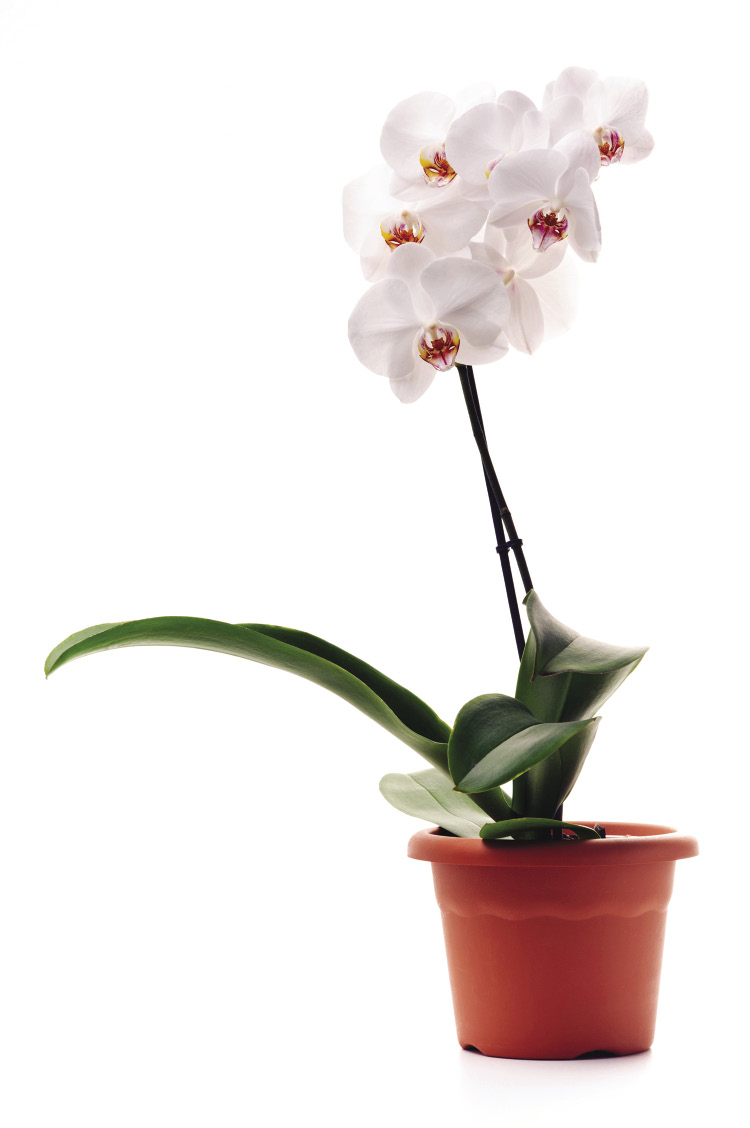
Phalaenopsis orchids are the most popular genera of orchids sold. They are available in white, pink, soft yellow, and light green, and they may be spotted with contrasting colors. Their unique form is reminiscent of an Ikebana floral arrangement due to the striking pattern of their long, dramatic bloom spikes. These spikes can hold anywhere from three to 30 flowers, and their retail price will depend on the number of blooms, and well as the size and age of the plant. If kept in bright, indirect light, such as in eastern or western exposures, they will remain in flower for up to 4 months.
It is possible to encourage the plant to send out more blooms after the first ones have faded. Prune the spike to the second or third node to encourage a lateral bloom spike to grow.
Phalaenopsis orchids are epiphytic plants by nature, meaning that their air roots cling to the bark on trees in their native habitats. For ease of display in the home or business, commercial producers plant them in bark, sphagnum moss or a combination of materials. These orchids do well when their roots are kept in evenly moist media and are sensitive to periods of dryness which will stress the flowers first, then the broad, flat-like leaves. Overwatering these plants by keeping media constantly wet will drastically shorten their display time. Overwatering and underwatering both result in flower loss and downturned leaves that may not fully recover.
Poinsettia
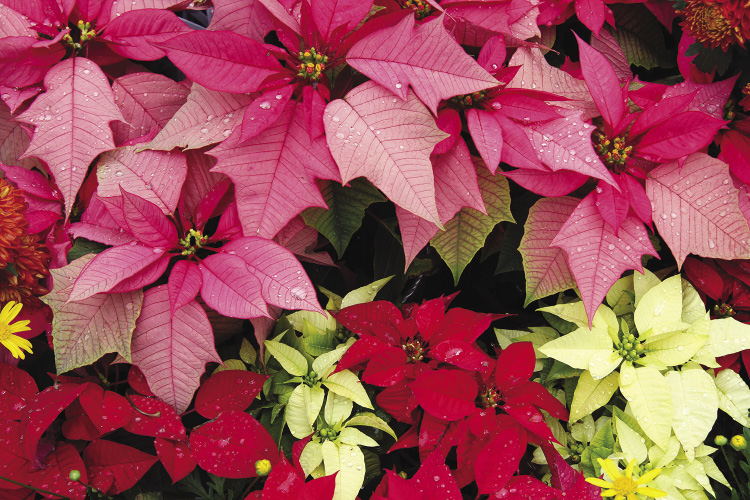
The poinsettia is the classic Christmas plant. It is possible to enjoy your poinsettia many weeks into the New Year. To prolong the bracts’ color, keep daytime temperatures between 68 and 72 degrees and nighttime temperatures about 60 degrees. Place the plant in a bright location. Poinsettias do not like drastic temperature changes, so keep them away from vents, radiators, and space heaters. For information on continued growth after Christmas and reflowering, see Extension Publication 2573, Selecting and Maintaining Poinsettias.
Note: Although research has shown the poinsettia to be nontoxic, it is not recommended for consumption by humans or animals. Some individuals may develop skin irritation when exposed to the milky sap.
Rosemary

Rosemary topiaries are popular during the holiday season because they are often shaped like Christmas trees and are very fragrant. With proper care, these topiaries can be kept alive long after the holiday season.
Rosemary prefers a sunny location in the home. They are native to the Mediterranean region and perform well in warm temperatures and well-drained soil. Rosemary does not like to have wet feet (roots), so make sure the plant is in well-drained soil. Water rosemary thoroughly but not often, based on the soil moisture level.
After the holiday season, you may move your rosemary plant outside and either keep it in the pot or plant it in your garden. Rosemary is a perennial in Mississippi and prefers full sun, but it will tolerate some shade. If you wish to keep the topiary’s shape, you will need to prune it often. Don’t discard the pruned pieces. Use them in the kitchen to liven up your cooking.
Thanksgiving Cactus

The main types of holiday cacti are Thanksgiving cactus (Schlumbergera truncata), Christmas cactus (Schlumbergera x buckleyi), and Easter cactus (Hatiora gaertneri).
The Thanksgiving cactus typically blooms early in the holiday season, from Thanksgiving through Christmas. The leaf margins on this cactus have two to four saw-toothed projections pointing upward on the sides of the stem. This cactus comes in several flower colors, ranging from red and lavender to salmon-orange and white.
The Christmas cactus blooms later in the season, from Christmas through March. The leaf margins usually have four rounded scallops along the edges of the stem. The flower colors are usually red and white.
Although not a winter holiday plant, the Easter cactus is a great plant to give in the spring. The Easter cactus generally blooms from March to May. It may bloom again in the fall. Flowers are usually pink or red. Leaf margins are smoother than the other seasonal cacti and have brownish, hair-like bristles at their tips.
Caring for holiday cacti is not difficult. They will bloom if kept in cooler parts of the house, away from heating vents. A coarse soil mix (high humus, sharp sand) that provides drainage is important. Keep the soil medium moist, not wet. Holiday cacti can easily be overwatered and are susceptible to root rot.
For repeat flowering, place cacti in a room with cool temperatures (60 to 65 degrees), stop fertilizing, allow the soil to become dry between waterings, and provide 12 hours of uninterrupted darkness every night for 5 to 6 weeks. Once flower buds appear, move the plants to a bright-light location and resume normal watering and fertilizing. Maintain cool temperatures (60 to 70 degrees) to avoid bud drop. Cacti are easy to propagate by making cuttings of stem sections. Propagation works best when done in early spring or summer.
Tulips
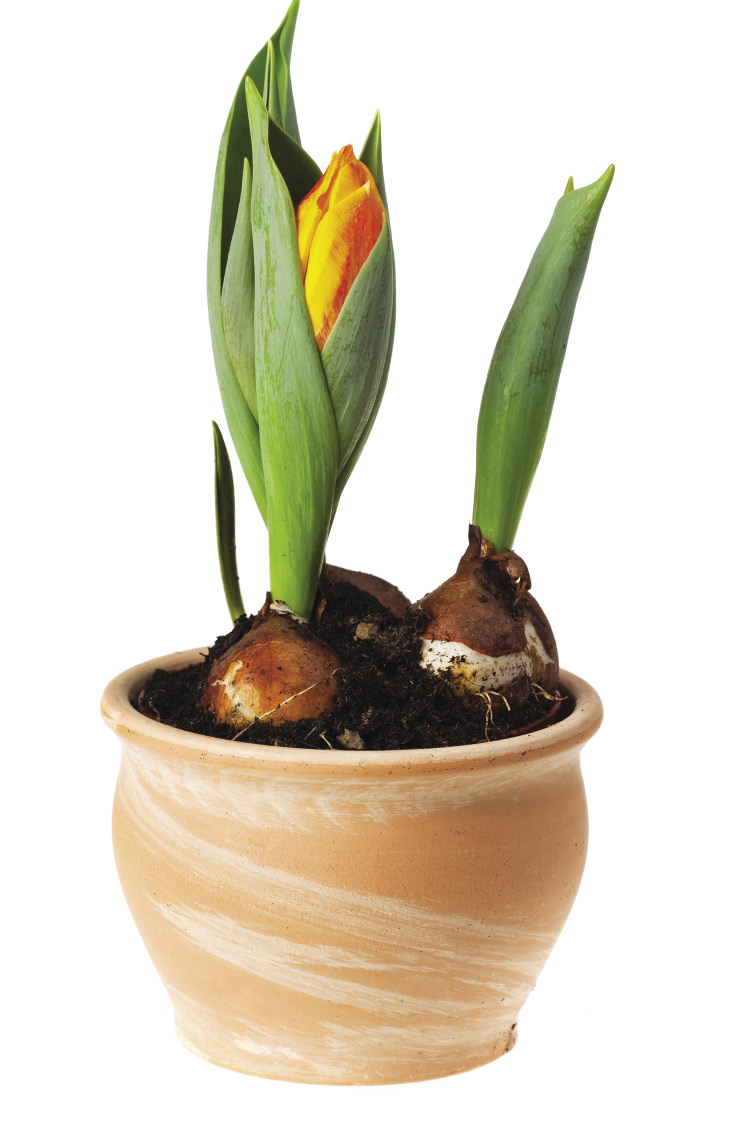
Potted tulip plants are special for winter and spring displays, and their wide color range provides a multitude of possibilities for holiday decorating and gift giving. Often, they are sold as 4-inch or 6-inch plants. Look for plants with flowers that are just beginning to show color for prolonged presentation. Warm rooms will expedite bloom, while cool rooms help you to keep the plant in flower longer. Consider keeping tulips in an unheated garage or covered porch at night and then bring them indoors at breakfast time. Even if this task is done for just a few nights, it will make a difference in their longevity.
You can purchase tulip bulbs in the fall and stratify them yourself. Follow the directions for forcing hyacinths described earlier in this publication. If you are targeting your plants to be in bloom on December 25, start this process on October 1.
Tulips forced into bloom do not thrive when planted in the garden. Often, our deep Southern climate is too hot for them to be considered perennials, but we can enjoy them as garden annuals by planting the bulbs in the fall.
References
Gilman, E., and Watson, D. Pinus pinea, Stone Pine. http://hort.ufl.edu/database/documents/pdf/tree_fact_sheets/pinpina.pdf
Hesperocyparis macrocarpa ‘Goldcrest’. North Carolina Extension Gardener Plant Toolbox. https://plants.ces.ncsu.edu/plants/hesperocyparis-macrocarpa-goldcrest/
Information and care instructions 12” tall lemon cypress cone pair in red tin. https://www.costco.com/wcsstore/CostcoUSBCCatalogAssetStore/Attachment/955345-Care_Instructions.pdf
Jauron, R., Klein, W. (2018) Yard and Garden: Forcing Papwerwhite Narcissus. Iowa State University. https://www.extension.iastate.edu/news/yard-and-garden-forcing-paperwhite-narcissus
Klingaman, G. Plant of the Week: Spruce, Dwarf Alberta.https://www.uaex.edu/yard-garden/resource-library/plant-week/dwarf-alberta-spruce.aspx.
National Chrysanthemum Society, USA. https://www.mums.org/
Seals, L., Fortsch, P., Hamilton, S. (2015). Growing Orchids in the Home. Agricultural Extension Service, The University of Tennessee. https://extension.tennessee.edu/publications/Documents/PB1634.pdf
Urban Forest Ecosystem Institute. https://selectree.calpoly.edu/tree-detail/hesperocyparis-macrocarpa
Weisenhorn, J. (2018). Growing bulbs indoors. https://extension.umn.edu/planting-and-growing-guides/growing-bulbs-indoors
Publication 2309
Revised by Jim DelPrince, Assistant Extension Professor, Coastal Research and Extension Center.
Copyright 2020 by Mississippi State University. All rights reserved. This publication may be copied and distributed without alteration for nonprofit educational purposes provided that credit is given to the Mississippi State University Extension Service.
Produced by Agricultural Communications.
Mississippi State University is an equal opportunity institution. Discrimination in university employment, programs, or activities based on race, color, ethnicity, sex, pregnancy, religion, national origin, disability, age, sexual orientation, genetic information, status as a U.S. veteran, or any other status protected by applicable law is prohibited. Questions about equal opportunity programs or compliance should be directed to the Office of Compliance and Integrity, 56 Morgan Avenue, P.O. 6044, Mississippi State, MS 39762, (662) 325-5839.
Extension Service of Mississippi State University, cooperating with U.S. Department of Agriculture. Published in furtherance of Acts of Congress, May 8 and June 30, 1914. GARY B. JACKSON, Director
The Mississippi State University Extension Service is working to ensure all web content is accessible to all users. If you need assistance accessing any of our content, please email the webteam or call 662-325-2262.


